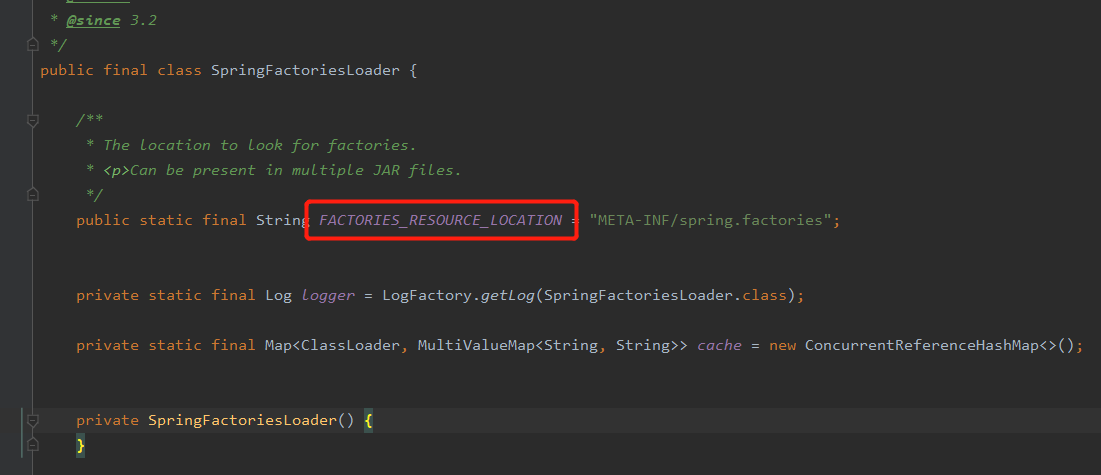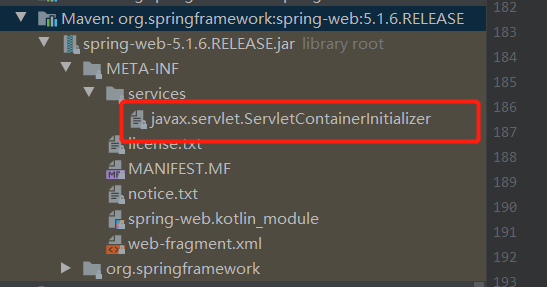Java spi机制
spi全称服务提供接口,Java 提供一些接口,供别人去实现,这种方式实现了设计模式中的单一职责,开闭原则,进行接口编程,不对原有逻辑进行硬编码,对实现类可插拔的使用
如果Java中对数据库驱动的加载就是利用spi机制实现的,如果使用mysql数据库只需添加mysql驱动,如果使用oracle数据库,只需添加oracle驱动
如果需要添加mysql驱动,就要在mysql驱动中添加一些配置


如上所示,java.sql.Driver是在java rt包中,之前在jvm中涉及到了类加载,这个包是启动类加载器来进行加载了
但是当我们加载mysql 驱动的时候,我们是把mysql驱动包加载在classpath下,并没有启动类加载器的扫描范围,所以启动类加载器加载不了这个类
这个时候就需要通过 当前线程类加载器了,当前线程类加载器会把类给启动类加载器去加载

由于启动类加载器是c++实现的,所以我们获取不到这个值
spring spi,是java spi的变种
springboot就是通过spring spi来进行自动装配的,其都是通过EnableAutoConfiguration来进行的


import就是把类加载到ioc容器中去

其中DeferredImportSelector实现了ImportSelector,这个就是可以通过一个string[],通过包路径+类名的方式,import到ioc容器中,其实这里只是去创建beanDefinition

再看下DeferredImportSelector的这个方法,这个方法就是将返回值中所有 的类导入到ioc容器中
public String[] selectImports(AnnotationMetadata annotationMetadata) {
if (!isEnabled(annotationMetadata)) {
return NO_IMPORTS;
}
AutoConfigurationMetadata autoConfigurationMetadata = AutoConfigurationMetadataLoader
.loadMetadata(this.beanClassLoader);
AutoConfigurationEntry autoConfigurationEntry = getAutoConfigurationEntry(
autoConfigurationMetadata, annotationMetadata);
return StringUtils.toStringArray(autoConfigurationEntry.getConfigurations());
}接下看下,这些类是从哪里获取的
protected AutoConfigurationEntry getAutoConfigurationEntry(
AutoConfigurationMetadata autoConfigurationMetadata,
AnnotationMetadata annotationMetadata) {
if (!isEnabled(annotationMetadata)) {
return EMPTY_ENTRY;
}
AnnotationAttributes attributes = getAttributes(annotationMetadata);
List<String> configurations = getCandidateConfigurations(annotationMetadata,
attributes);
configurations = removeDuplicates(configurations);
Set<String> exclusions = getExclusions(annotationMetadata, attributes);
checkExcludedClasses(configurations, exclusions);
configurations.removeAll(exclusions);
configurations = filter(configurations, autoConfigurationMetadata);
fireAutoConfigurationImportEvents(configurations, exclusions);
return new AutoConfigurationEntry(configurations, exclusions);
} protected List<String> getCandidateConfigurations(AnnotationMetadata metadata,
AnnotationAttributes attributes) {
List<String> configurations = SpringFactoriesLoader.loadFactoryNames(
getSpringFactoriesLoaderFactoryClass(), getBeanClassLoader());
Assert.notEmpty(configurations,
"No auto configuration classes found in META-INF/spring.factories. If you "
+ "are using a custom packaging, make sure that file is correct.");
return configurations;
}此时这个factoryClass 传入的值是 EnableAutoConfiguration
public static List<String> loadFactoryNames(Class<?> factoryClass, @Nullable ClassLoader classLoader) {
String factoryClassName = factoryClass.getName();
return loadSpringFactories(classLoader).getOrDefault(factoryClassName, Collections.emptyList());
}private static Map<String, List<String>> loadSpringFactories(@Nullable ClassLoader classLoader) {
MultiValueMap<String, String> result = cache.get(classLoader);
if (result != null) {
return result;
}
try {
Enumeration<URL> urls = (classLoader != null ?
classLoader.getResources(FACTORIES_RESOURCE_LOCATION) :
ClassLoader.getSystemResources(FACTORIES_RESOURCE_LOCATION));
result = new LinkedMultiValueMap<>();
while (urls.hasMoreElements()) {
URL url = urls.nextElement();
UrlResource resource = new UrlResource(url);
Properties properties = PropertiesLoaderUtils.loadProperties(resource);
for (Map.Entry<?, ?> entry : properties.entrySet()) {
String factoryClassName = ((String) entry.getKey()).trim();
for (String factoryName : StringUtils.commaDelimitedListToStringArray((String) entry.getValue())) {
result.add(factoryClassName, factoryName.trim());
}
}
}
cache.put(classLoader, result);
return result;
}
catch (IOException ex) {
throw new IllegalArgumentException("Unable to load factories from location [" +
FACTORIES_RESOURCE_LOCATION + "]", ex);
}
}其中这行就是核心代码Enumeration<URL> urls = (classLoader != null ? classLoader.getResources(FACTORIES_RESOURCE_LOCATION) :ClassLoader.getSystemResources(FACTORIES_RESOURCE_LOCATION));

这个就是加载配置文件,然后生成一个Map<String, List<String>>对象
从springboot包中看下这个配置文件:

所以之前传入的key是EnableAutoConfiguration,则这里会加载下面所有的value
如加载org.springframework.boot.autoconfigure.web.client.RestTemplateAutoConfiguration,
这里注意,加载配置文件 可以通过java io去加载,也可以通过classload去加载
java io可以加载classpath之外的文件
classload只能加载classpath之类的配置文件
springboot内嵌tomcat
顺序:1、先启动ioc容器 自动配置tomcat,
2、再启动tomcat
3、启动后 new dispatchServlet把dispatchServlet实例注入到tomcat中,实现tomcat向springMvc的转发
1、自动配置tomcat ,使用了spring spi技术
org.springframework.boot.autoconfigure.web.servlet.ServletWebServerFactoryAutoConfiguration,
@Configuration
@AutoConfigureOrder(Ordered.HIGHEST_PRECEDENCE)
@ConditionalOnClass(ServletRequest.class)
@ConditionalOnWebApplication(type = Type.SERVLET)
@EnableConfigurationProperties(ServerProperties.class)
@Import({ ServletWebServerFactoryAutoConfiguration.BeanPostProcessorsRegistrar.class,
ServletWebServerFactoryConfiguration.EmbeddedTomcat.class,
ServletWebServerFactoryConfiguration.EmbeddedJetty.class,
ServletWebServerFactoryConfiguration.EmbeddedUndertow.class })
public class ServletWebServerFactoryAutoConfiguration {
@Bean
public ServletWebServerFactoryCustomizer servletWebServerFactoryCustomizer(
ServerProperties serverProperties) {
return new ServletWebServerFactoryCustomizer(serverProperties);
}
@Bean
@ConditionalOnClass(name = "org.apache.catalina.startup.Tomcat")
public TomcatServletWebServerFactoryCustomizer tomcatServletWebServerFactoryCustomizer(
ServerProperties serverProperties) {
return new TomcatServletWebServerFactoryCustomizer(serverProperties);
}
......................................
}ServerProperties是扫描 配置文件信息的,
@ConditionalOnClass(name = "org.apache.catalina.startup.Tomcat") 是classPath中有org.apache.catalina.startup.Tomcat就是启动tomcat容器,springboot自带,且默认的
2、启动tomcat

3、启动后把dispatchServlet注入到tomcat中,实现tomcat向springMvc的转发 这里使用到了sevlet 3.0技术,sevlet spi


在tomcat启动后,会去执行上面那个文件的类的onStartup方法
/*
* Copyright 2002-2018 the original author or authors.
*
* Licensed under the Apache License, Version 2.0 (the "License");
* you may not use this file except in compliance with the License.
* You may obtain a copy of the License at
*
* https://www.apache.org/licenses/LICENSE-2.0
*
* Unless required by applicable law or agreed to in writing, software
* distributed under the License is distributed on an "AS IS" BASIS,
* WITHOUT WARRANTIES OR CONDITIONS OF ANY KIND, either express or implied.
* See the License for the specific language governing permissions and
* limitations under the License.
*/
package org.springframework.web;
import java.lang.reflect.Modifier;
import java.util.LinkedList;
import java.util.List;
import java.util.ServiceLoader;
import java.util.Set;
import javax.servlet.ServletContainerInitializer;
import javax.servlet.ServletContext;
import javax.servlet.ServletException;
import javax.servlet.annotation.HandlesTypes;
import org.springframework.core.annotation.AnnotationAwareOrderComparator;
import org.springframework.lang.Nullable;
import org.springframework.util.ReflectionUtils;
/**
* Servlet 3.0 {@link ServletContainerInitializer} designed to support code-based
* configuration of the servlet container using Spring's {@link WebApplicationInitializer}
* SPI as opposed to (or possibly in combination with) the traditional
* {@code web.xml}-based approach.
*
* <h2>Mechanism of Operation</h2>
* This class will be loaded and instantiated and have its {@link #onStartup}
* method invoked by any Servlet 3.0-compliant container during container startup assuming
* that the {@code spring-web} module JAR is present on the classpath. This occurs through
* the JAR Services API {@link ServiceLoader#load(Class)} method detecting the
* {@code spring-web} module's {@code META-INF/services/javax.servlet.ServletContainerInitializer}
* service provider configuration file. See the
* <a href="https://download.oracle.com/javase/6/docs/technotes/guides/jar/jar.html#Service%20Provider">
* JAR Services API documentation</a> as well as section <em>8.2.4</em> of the Servlet 3.0
* Final Draft specification for complete details.
*
* <h3>In combination with {@code web.xml}</h3>
* A web application can choose to limit the amount of classpath scanning the Servlet
* container does at startup either through the {@code metadata-complete} attribute in
* {@code web.xml}, which controls scanning for Servlet annotations or through an
* {@code <absolute-ordering>} element also in {@code web.xml}, which controls which
* web fragments (i.e. jars) are allowed to perform a {@code ServletContainerInitializer}
* scan. When using this feature, the {@link SpringServletContainerInitializer}
* can be enabled by adding "spring_web" to the list of named web fragments in
* {@code web.xml} as follows:
*
* <pre class="code">
* <absolute-ordering>
* <name>some_web_fragment</name>
* <name>spring_web</name>
* </absolute-ordering>
* </pre>
*
* <h2>Relationship to Spring's {@code WebApplicationInitializer}</h2>
* Spring's {@code WebApplicationInitializer} SPI consists of just one method:
* {@link WebApplicationInitializer#onStartup(ServletContext)}. The signature is intentionally
* quite similar to {@link ServletContainerInitializer#onStartup(Set, ServletContext)}:
* simply put, {@code SpringServletContainerInitializer} is responsible for instantiating
* and delegating the {@code ServletContext} to any user-defined
* {@code WebApplicationInitializer} implementations. It is then the responsibility of
* each {@code WebApplicationInitializer} to do the actual work of initializing the
* {@code ServletContext}. The exact process of delegation is described in detail in the
* {@link #onStartup onStartup} documentation below.
*
* <h2>General Notes</h2>
* In general, this class should be viewed as <em>supporting infrastructure</em> for
* the more important and user-facing {@code WebApplicationInitializer} SPI. Taking
* advantage of this container initializer is also completely <em>optional</em>: while
* it is true that this initializer will be loaded and invoked under all Servlet 3.0+
* runtimes, it remains the user's choice whether to make any
* {@code WebApplicationInitializer} implementations available on the classpath. If no
* {@code WebApplicationInitializer} types are detected, this container initializer will
* have no effect.
*
* <p>Note that use of this container initializer and of {@code WebApplicationInitializer}
* is not in any way "tied" to Spring MVC other than the fact that the types are shipped
* in the {@code spring-web} module JAR. Rather, they can be considered general-purpose
* in their ability to facilitate convenient code-based configuration of the
* {@code ServletContext}. In other words, any servlet, listener, or filter may be
* registered within a {@code WebApplicationInitializer}, not just Spring MVC-specific
* components.
*
* <p>This class is neither designed for extension nor intended to be extended.
* It should be considered an internal type, with {@code WebApplicationInitializer}
* being the public-facing SPI.
*
* <h2>See Also</h2>
* See {@link WebApplicationInitializer} Javadoc for examples and detailed usage
* recommendations.<p>
*
* @author Chris Beams
* @author Juergen Hoeller
* @author Rossen Stoyanchev
* @since 3.1
* @see #onStartup(Set, ServletContext)
* @see WebApplicationInitializer
*/
@HandlesTypes(WebApplicationInitializer.class)
public class SpringServletContainerInitializer implements ServletContainerInitializer {
/**
* Delegate the {@code ServletContext} to any {@link WebApplicationInitializer}
* implementations present on the application classpath.
* <p>Because this class declares @{@code HandlesTypes(WebApplicationInitializer.class)},
* Servlet 3.0+ containers will automatically scan the classpath for implementations
* of Spring's {@code WebApplicationInitializer} interface and provide the set of all
* such types to the {@code webAppInitializerClasses} parameter of this method.
* <p>If no {@code WebApplicationInitializer} implementations are found on the classpath,
* this method is effectively a no-op. An INFO-level log message will be issued notifying
* the user that the {@code ServletContainerInitializer} has indeed been invoked but that
* no {@code WebApplicationInitializer} implementations were found.
* <p>Assuming that one or more {@code WebApplicationInitializer} types are detected,
* they will be instantiated (and <em>sorted</em> if the @{@link
* org.springframework.core.annotation.Order @Order} annotation is present or
* the {@link org.springframework.core.Ordered Ordered} interface has been
* implemented). Then the {@link WebApplicationInitializer#onStartup(ServletContext)}
* method will be invoked on each instance, delegating the {@code ServletContext} such
* that each instance may register and configure servlets such as Spring's
* {@code DispatcherServlet}, listeners such as Spring's {@code ContextLoaderListener},
* or any other Servlet API componentry such as filters.
* @param webAppInitializerClasses all implementations of
* {@link WebApplicationInitializer} found on the application classpath
* @param servletContext the servlet context to be initialized
* @see WebApplicationInitializer#onStartup(ServletContext)
* @see AnnotationAwareOrderComparator
*/
@Override
public void onStartup(@Nullable Set<Class<?>> webAppInitializerClasses, ServletContext servletContext)
throws ServletException {
List<WebApplicationInitializer> initializers = new LinkedList<>();
if (webAppInitializerClasses != null) {
for (Class<?> waiClass : webAppInitializerClasses) {
// Be defensive: Some servlet containers provide us with invalid classes,
// no matter what @HandlesTypes says...
if (!waiClass.isInterface() && !Modifier.isAbstract(waiClass.getModifiers()) &&
WebApplicationInitializer.class.isAssignableFrom(waiClass)) {
try {
initializers.add((WebApplicationInitializer)
ReflectionUtils.accessibleConstructor(waiClass).newInstance());
}
catch (Throwable ex) {
throw new ServletException("Failed to instantiate WebApplicationInitializer class", ex);
}
}
}
}
if (initializers.isEmpty()) {
servletContext.log("No Spring WebApplicationInitializer types detected on classpath");
return;
}
servletContext.log(initializers.size() + " Spring WebApplicationInitializers detected on classpath");
AnnotationAwareOrderComparator.sort(initializers);
for (WebApplicationInitializer initializer : initializers) {
initializer.onStartup(servletContext);
}
}
}
其中有个注解,是tomcat实现的,@HandlesTypes(WebApplicationInitializer.class) 这个会加载WebApplicationInitializer实现类作为onStartup方法的参数

protected void registerDispatcherServlet(ServletContext servletContext) {
String servletName = getServletName();
Assert.hasLength(servletName, "getServletName() must not return null or empty");
WebApplicationContext servletAppContext = createServletApplicationContext();
Assert.notNull(servletAppContext, "createServletApplicationContext() must not return null");
FrameworkServlet dispatcherServlet = createDispatcherServlet(servletAppContext);
Assert.notNull(dispatcherServlet, "createDispatcherServlet(WebApplicationContext) must not return null");
dispatcherServlet.setContextInitializers(getServletApplicationContextInitializers());
ServletRegistration.Dynamic registration = servletContext.addServlet(servletName, dispatcherServlet);
if (registration == null) {
throw new IllegalStateException("Failed to register servlet with name '" + servletName + "'. " +
"Check if there is another servlet registered under the same name.");
}
registration.setLoadOnStartup(1);
registration.addMapping(getServletMappings());
registration.setAsyncSupported(isAsyncSupported());
Filter[] filters = getServletFilters();
if (!ObjectUtils.isEmpty(filters)) {
for (Filter filter : filters) {
registerServletFilter(servletContext, filter);
}
}
customizeRegistration(registration);
}这里做了转发处理
最后
以上就是炙热刺猬最近收集整理的关于springboot自动装配及spi的全部内容,更多相关springboot自动装配及spi内容请搜索靠谱客的其他文章。








发表评论 取消回复